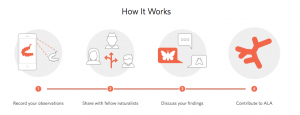Some ALA users will be familiar with iNaturalist, the global online community for naturalists. By becoming a member of the iNaturalist Network, the ALA will have its own local node called iNaturalist Australia.
Over the next few months, we’ll be working with iNaturalist to implement iNaturalist Australia. Already, all data collected and shared with iNaturalist can be viewed in the ALA. The collaboration will focus on using the iNaturalist platform for individual sightings in the ALA, leading to better species identification and data quality, as well as providing access to the largest biodiversity-loving community on the planet.

The iNaturalist community
iNaturalist is a great platform for supporting discussions and discoveries about species. Fundamentally, iNaturalist is a species occurrence recording tool and a crowdsourced species identification system. Its main goals are to connect people to nature, to enhance understanding of life on Earth and encourage people to value it. iNaturalist does this by generating scientifically credible biodiversity data from personal encounters with the natural world.
There are two types of users in iNaturalist:
- Observers: are people who are keen to document and record the biodiversity around them using photos or sounds.
- Identifiers: are people willing to put on their taxonomist’s hat and improve the quality of the records by agreeing or disagreeing on the suggested species. Many identifiers are experts in their field, but they can also be citizen scientists who have an interest in taxonomy. Identifiers underpin the iNaturalist identification system.
Benefits of the ALA–iNaturalist collaboration for ALA users
Improved Species identification
One of the most frequent questions from citizen scientists to our ALA support team is about species identification. Up to now, we’ve only been able to advise users how to seek out species identification for themselves e.g. contact their closest natural history museum or herbarium.
iNaturalist provides access to a larger network of species identifiers – citizen scientists and biologists who identify and verify sightings. This will improve the quality of individual human observation data in the ALA. In turn, this means, individual human observation data will have greater benefit to biodiversity science.
iNaturalist is also a world leader in using machine learning to identify species in an image, this helps speed up the identification process. At the moment it takes an average of 18 days for the community to identify a species, but over half are completed within 2 days.
Improved data quality
As a repository of data from a large number of different data providers, the ALA is continually working on improving the quality of data and improving tools to filter and analyse data. By using crowdsourced identifications, iNaturalist Australia will improve the quality of individual human observations in the ALA. And better data quality means improved outcomes for biodiversity science.

Watch this space!
We’re working with the iNaturalist platform to make sure we provide the best user experience and data flows for our citizen scientists currently uploading sightings to the ALA.
For more information on iNaturalist Australia, please contact support@ala.org.au